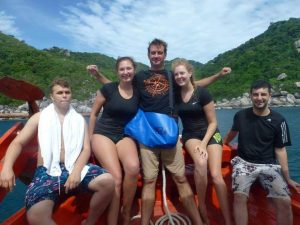 Recently the guys from the DJL Tech Department teamed up with Roctopus Tech and Koh Tao Tech Divers. The mission was to set off from Koh Tao and explore the Torpedo Wreck. DJL Tech Instructor Ed has written an account of the journey to the wreck for SEA Explorers Club.
Recently the guys from the DJL Tech Department teamed up with Roctopus Tech and Koh Tao Tech Divers. The mission was to set off from Koh Tao and explore the Torpedo Wreck. DJL Tech Instructor Ed has written an account of the journey to the wreck for SEA Explorers Club.
The Torpedo Wreck
At DJL Tech we are always keeping a keen eye on the weather. Waiting for a good opportunity to dive the more interesting wrecks in the area. Eventually we spot that a calm period is coming and the message goes out to Koh Taos’ community of technical divers. Soon we would have an opportunity to dive the Torpedo Wreck. On the trip were divers from Koh Tao Tec Divers and Roctopus Tech, as well as a team from DJL Tech.
We spent the previous afternoon preparing our equipment. In all we had 5 divers using closed circuit rebreathers (advanced computer controlled dive equipment) and 6 using the more traditional twin tank setup. Many of the divers chose to dive using trimix, a blend of oxygen, nitrogen and helium. This gives a massive reduction in narcosis which subsequently enables clear thinking and quick decision making at depth.
Heading out on the boat
We met at 7AM and loaded our equipment onto the dive boat. The 2 hour journey offered time to perform final safety checks on our equipment and to finalize the details of our dive plan. Finally we arrived at the dive site and started the highly skilled task of marking the wreck. This involves searching the area indicated by the GPS unit and carefully monitoring the sonar looking for the telltale return of the wrecks structure. At the crucial moment the weighted ‘shot’’ line is thrown into the water which is attached to a counterweighted float. This marks the dive site and gives the divers a guide for their descents and ascents.
Dive one
The first team into the water were from DJL, led by veteran technical diver Tim Lawrence. We made our descent, including the standard equipment and bubble checks on our way down. Next we made a final group check before punching through the thermocline, followed by the nerve wracking few seconds to see if our shot had hit its target. We got to the bottom of the line to find the shot had landed perfectly in the ships hold, settling a few meters away from the bridge. Tim tied the line into the top of the bridge structure and sent up a lift bag to signal the boat and other divers we were in the right place.
We were surrounded by marine life, schools of batfish and barracuda. Firstly I tied off a navigation line and we then set off to explore the structure of the wreck. The Torpedo is a 70m long Japanese cargo vessel. There are great penetrations available on several of the ships decks. Interestingly it is known as the Torpedo wreck because when first discovered the cargo of teak logs was mistaken for torpedoes.
As we started our ascent and decompression obligations other divers were passing, heading down to start their first dive.
Dive two
Upon returning to the surface we eat a spot of lunch. We also refill our gas and make sure we have a decent surface interval. On the second dive we add a lift bag to the shot weight to help with its recovery. After making it secure we make some interesting exploration of the bridge block.
We settled in for the journey back and arrived at Sairee at around 6PM.
Lying in around 50m of seawater this wreck is well beyond the range of recreational scuba diving limits.
Contact us
Want to find out more about training to complete this type of challenging diving? Contact the DJL Tech team at info@techdivethailand.com. We will be happy to answer any questions about our range of technical diving courses from PADI/DSAT, ANDI and BSAC.

